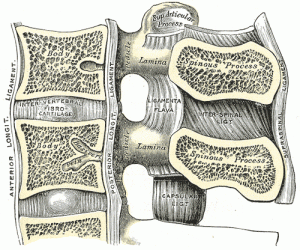The bodies of adjacent vertebrae are strongly anchored to each other in their anterior part by an intervertebral disc. This structure provides padding between the bones during weight bearing, and because it can change shape, also allows for movement between the vertebrae. The vertebral arches, posteriorly, provide extra anchorage.
Although the total amount of movement available between any two adjacent vertebrae is small, when these movements are summed together along the entire length of the vertebral column, large body movements can be produced. Ligaments that extend along the length of the vertebral column also contribute to its overall support and stability.
The articulations of the vertebral column consist of:
- a series of Plane Joint – Arthrodial Joint (amphiarthrodial joints) between the vertebral bodies: see the intervertebral discs.
- and another series of Plane Joint – Arthrodial Joint (diathrodial joints) between the vertebral arches: see Articulations of Vertebral Arches.
Movements
In general, the movements permitted in the vertebral column are: flexion, extension, lateral movement, circumduction, and rotation.
- In Flexion, or movement forward, the anterior longitudinal ligament is relaxed, and the intervertebral fibrocartilages are compressed in front; while the posterior longitudinal ligament, the ligamenta flava, and the inter- and supraspinal ligaments are stretched, as well as the posterior fibers of the intervertebral fibrocartilages. The interspaces between the laminæ are widened, and the inferior articular processes glide upward, upon the superior articular processes of the subjacent vertebrae. Flexion is the most extensive of all the movements of the vertebral column, and is freest in the lumbar region.
- In Extension, or movement backward, an exactly opposite disposition of the parts takes place. This movement is limited by the anterior longitudinal ligament, and by the approximation of the spinous processes. It is freest in the cervical region.
- In Lateral movement, the sides of the intervertebral fibrocartilages are compressed, the extent of motion being limited by the resistance offered by the surrounding ligaments. This movement may take place in any part of the column, but is freest in the cervical and lumbar regions.
- Circumduction is very limited, and is merely a succession of the preceding movements.
- Rotation is produced by the twisting of the intervertebral fibrocartilages; this, although only slight between any two vertebrae, allows of a considerable extent of movement when it takes place in the whole length of the column, the front of the upper part of the column being turned to one or other side. This movement occurs to a slight extent in the cervical region, is freer in the upper part of the thoracic region, and absent in the lumbar region.
But there are some differences in vertebral movements in the different regions of the spine. The extent and variety of the movements are influenced by the shape and direction of the articular surfaces:
- Group Cervical
- Jnt Thoracic
- Jnt Lumbar

